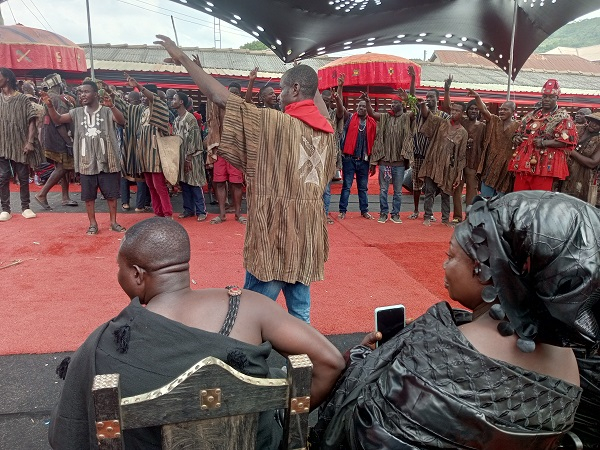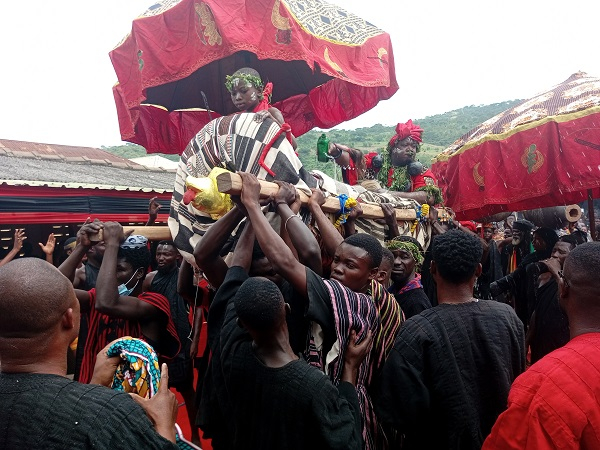Correspondence from the Eastern Region
The Kyidomhene of the Boso-Gua Traditional Area in the Eastern Region has implored the government and other pivotal stakeholders to capitalise on the extensive potential within Boso-Gua’s tourism sector as a strategic instrument not only for generating employment but also for addressing the economic challenges confronting the nation.
Ahunabobrim Akuamoh Kwao II, in an interview during the ancestral burial of the 25 deceased chiefs and a queen mother, underscored that tourism represents the most accessible and effective pathway to attracting both local and international investments.
He accentuated that tourism not only serves as a source of revenue generation but also possesses the capacity to create employment, promote local culture, and open rural communities to developmental opportunities.
In his appeal to the government and the President to harness the town’s tourism potential, he expressed, “Boso, we’re now emerging, so the government should direct its attention, its focus, on Boso; they should place their trust in us, we are prepared to collaborate with the government, we have the Volta River coursing through, we have a populace well-versed in the nuances of tourism.”
Highlighting the significance of the ancestral burial, Ahunabobrim Akuamoh Kwao II emphasized the necessity for unity, stating, “This is not merely about culture but encompasses the unity that binds us within the community.”
The Kyidomhene, while extolling his predecessors, remarked: “Throughout the course of 25 illustrious reigns, these chiefs have adeptly navigated challenges and championed initiatives that have enriched and shaped our community into what it is today.”
Elucidating the role of culture in contemporary society, he asserted the imperative to perpetuate the customs and traditions bequeathed by our ancestors, an aspiration he revealed was the cornerstone of the ancestral burial.
According to him, the absence of guidance for today’s youth has precipitated their waywardness. He lamented, “Currently, the youth are left to their own devices, society is adrift, and individuals exhibit a lack of concern for one another; we have forsaken our youth, but that is not our culture; our culture embodies togetherness, our culture epitomises unity.”
He traced the establishment of the Boso-Gua community to its inaugural chief, Ahunabobrim Akuamoah Kwao II, remarking that it is a legacy worthy of celebration. “They’ve entrusted a community into my stewardship, a community characterised by unity, a community of prosperity, a community with a promising future, and it is my responsibility to uphold and advance it.”
About the Ancestral Funeral
The week-long event, observed from Monday, July 14 to Sunday, July 20, 2025, ensured that the final funeral rites for the late chiefs—from Ahunabobrim Akuamoah Kwao II through Ohemaa Nene Asantewaa Aburam I to Nana Ansah Asuman II, whose reign spanned from 1998 to 2019—were conducted with the utmost dignity.
The occasion witnessed the final funeral rites being performed for 25 late chiefs and one queen mother of Boso-Gua, who had departed since the 1880s. Although many chiefs were installed in the past, final funeral rites for deceased predecessors had not been performed, necessitating a grand occasion to bid a fitting farewell to all the late rulers who contributed to and left behind enduring legacies for Boso-Gua and its inhabitants.
Expounding on the essence of the occasion, Seth Junior Obeng-Frimpong, a royal from the Amoakarle family, remarked: “In any traditional setting, it is imperative that as you conduct burials, you also perform the funerals; it paves the way for numerous subsequent endeavors… for us in the Amoakarle family, having the Kyidomhene as part of our lineage, we deemed it wise to conduct the ancestral funeral for all our past chiefs, not solely for the Kyidomhene who have come and gone but also for the various sub-chiefs within the Amoakarle family.”
He asserted the necessity for Ghanaians and the global community to recognize the true identity of Boso-Gua. “We desire the world to comprehend what Boso represents,” he stated.
Moses Danso Aburam, Amoakarle Abusuapanyin, in a tribute to the Amoakarle Ancestry, articulated: “Each chief has traversed the path of service, laying the groundwork for future generations to inherit a legacy steeped in respect, dignity, and communal pride.”
The activities encompassed a visit to the ancestral home, engagement with nananom edikanfo, traditional performances of rites, nsiesie edwumadi, nananom akomfo agorodee kese, and various cultural displays by asafoatses, culminating in a night vigil adorned with cultural performances, tete amamere, and abakosem, among other events.
Notable traditional leaders, including the Paramount Chief of Peki Traditional Area, Deiga Kwadzodeh Dei XII, the Paramount Chief of Anfoeta, Togbe Kwasi Drah VII, and the Paramount Chief of Kpalime, Togbega Atikpladza Agbi Yao VIII, along with numerous queen mothers and royals from the Volta and Eastern Regions, gathered with mourners to bestow a dignified farewell upon the late chiefs.
Also present were politicians, clergy, and other mourners from diverse backgrounds. The event enveloped the Boso-Gua Township in a sombre atmosphere as royals, predominantly clad in red and black attire and traditional regalia, sang dirges and paraded through the community.
Traditional warriors also participated in the ceremonies, punctuating the proceedings with the sporadic firing of muskets. The elaborate event mirrored the esteemed status of the late chiefs and their profound connection to their ancestors.
The ceremonies incorporated unique rituals and customs, including the utilisation of traditional music, attire, and symbols, which constituted not merely a farewell but a means to honor the lineage of the deceased and ensure their seamless transition to the spirit realm.
Despite the prevailing grief, the atmosphere fostered a sense of unity, as indigenes of Boso-Gua from far and wide returned home to converge at the community durbar grounds for this momentous occasion.



